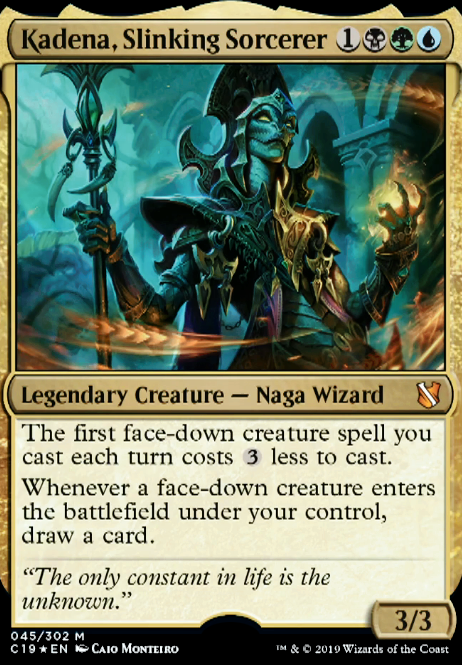
You Just Activated My Trap Card!
Commander / EDH BUG (Sultai) Casual Control Flash Goodstuff Megamorph Morph Primer Storm Theme/Gimmick
Creature (32)
- 1x Ainok Survivalist
- 1x Augur of Autumn
- 1x Bane of the Living
- 1x Beast Whisperer
- 1x Birds of Paradise
- 1x Bloom Tender
- 1x Brine Elemental
- 1x Chromeshell Crab
- 1x Den Protector
- 1x Echo Tracer
- 1x Eternal Witness
- 1x Grazilaxx, Illithid Scholar
- 1x Grim Haruspex
- 1x Icefeather Aven
- 1x Ixidron
- 1x Kadena's Silencer
- 1x Kheru Spellsnatcher
- 1x Mischievous Quanar
- 1x Mistfire Weaver
- 1x Nantuko Vigilante
- 1x Ruthless Ripper
- 1x Sanctum Weaver
- 1x Seedborn Muse
- 1x Silumgar Assassin
- 1x Stratus Dancer
- 1x Teferi, Mage of Zhalfir
- 1x Temur Sabertooth
- 1x Unblinking Bleb
- 1x Vesuvan Shapeshifter
- 1x Voidmage Apprentice
- 1x Willbender
- 1x Yedora, Grave Gardener
Sorcery (3)
Land (34)
- 1x Alchemist's Refuge
- 1x Bloodstained Mire
- 1x Bojuka Bog
-
1x
Breeding Pool

- 1x Command Tower
- 1x Exotic Orchard
- 1x Flooded Strand
- 4x Forest
- 4x Island
- 1x Marsh Flats
- 1x Misty Rainforest
- 1x Nurturing Peatland
-
1x
Overgrown Tomb

- 1x Polluted Delta
- 1x Prismatic Vista
- 1x Reliquary Tower
- 1x Riptide Laboratory
- 1x Scalding Tarn
- 2x Swamp
- 1x Tomb of the Spirit Dragon
- 1x Verdant Catacombs
- 1x Waterlogged Grove
-
1x
Watery Grave

- 1x Winding Canyons
- 1x Windswept Heath
- 1x Wooded Foothills
- 1x Zoetic Cavern
Artifact (5)
Planeswalker (2)
Commander (1)
Enchantment (15)
- 1x Earthcraft
- 1x Equilibrium
- 1x Exploration
- 1x Gift of Doom
- 1x Growing Rites of Itlimoc Flip
- 1x Guardian Project
- 1x Heartless Summoning
- 1x Leyline of Anticipation
- 1x Mystic Remora
- 1x Obscuring Aether
- 1x Rhystic Study
- 1x Secret Plans
- 1x Sylvan Library
- 1x Utopia Sprawl
- 1x Wild Growth
Instant (8)
Maybeboard
Enchantment (1)
Artifact (1)
Suggestions
Comments View Archive
Attention! Complete Comment Tutorial! This annoying message will go away once you do!
Important! Formatting tips — Comment Tutorial — markdown syntax
Please login to comment
Revision 33 See all
(3 years ago)
| -1 | Burgeoning | main |
| -1 | Ghastly Conscription | main |
| +1 | Sanctum Weaver | main |
| +1 | Utopia Sprawl | main |
| +1 | Wild Growth | main |
| -1 | Words of Wind | main |
| Top Ranked |
|
| Date added | 5 years |
| Last updated | 3 years |
| Legality | This deck is Commander / EDH legal. |
| Rarity (main - side) | 2 - 0 Mythic Rares 61 - 0 Rares 16 - 0 Uncommons 11 - 0 Commons |
| Cards | 100 |
| Avg. CMC | 2.65 |
| Tokens | Morph 2/2 C, Spirit 2/2 C |
| Folders | Sources d'inspiration, Deck Ideas, Potential build, EDH, Things to think on..., Decks, Masked Riders, Edh decks, commander decks, Cool Decks |
| Votes | |
| Ignored suggestions | |
| Shared with | |
| Views |




 Let's say we have gathered a win con, but an opponent casts
Let's say we have gathered a win con, but an opponent casts 

